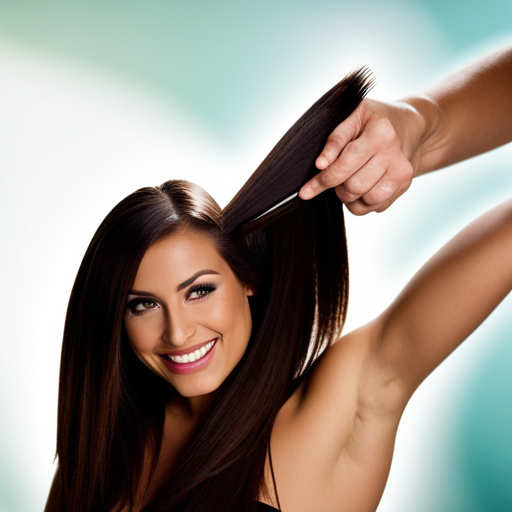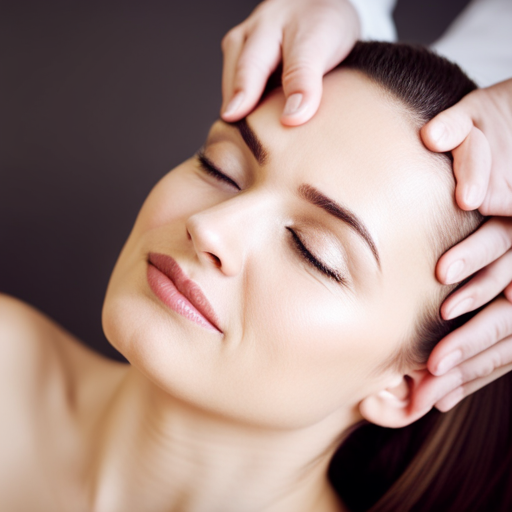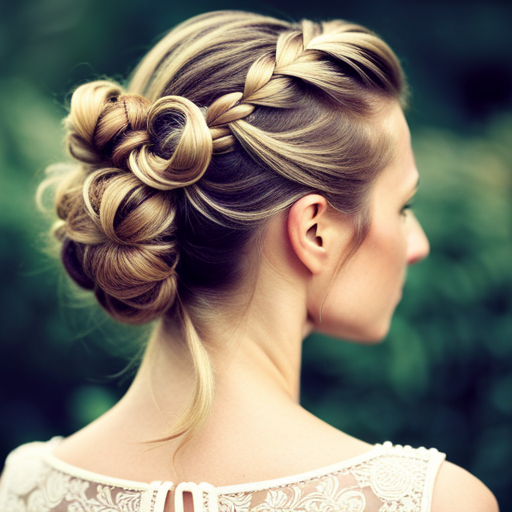Salvaging Hairstyles From Wind and Rain Exposure

‘Like the saying goes, ‘April showers bring May flowers,’ but they can also wreak havoc on your carefully styled hair. In this article, we will explore effective strategies for salvaging hairstyles from wind and rain exposure.
From understanding hair behavior in adverse weather to quick fixes for frizzy and flat hair, we’ll provide professional tips to help you maintain a polished look despite the elements.
Let’s ensure your hair stays resilient and stylish no matter what the forecast brings.’
Understanding Hair Behavior in Wind and Rain
One of the primary concerns for individuals exposed to wind and rain is the impact on their hairstyles, necessitating a thorough understanding of how hair behaves in these conditions.
Hair porosity, moisture retention, texture, and elasticity are crucial factors to consider when evaluating hair’s response to wind and rain. Porosity determines how well hair absorbs and retains moisture, making it essential in understanding how hair will react in damp or humid conditions. Additionally, the ability of hair to retain moisture affects its flexibility and overall resilience to wind and rain.
Hair texture plays a role in how it responds to external elements, with finer hair being more susceptible to frizz and damage in adverse weather. Elasticity, the hair’s ability to stretch and return to its original state, is imperative for wind and rain resistance, as it influences the hair’s capacity to withstand the forces exerted by these elements.
Understanding these key characteristics of hair helps individuals make informed decisions when choosing products and styling methods to protect their hair from wind and rain.
Transitioning into the subsequent section about ‘pre-styling preparation for weather resistance’, it is evident that a comprehensive understanding of hair behavior is essential for effective hair care in adverse weather conditions.
Pre-Styling Preparation for Weather Resistance
Preparing your hair for weather resistance requires careful consideration of suitable products and styling techniques.
Hair serums are essential for creating a protective barrier against wind and rain. When applying hair serums, it’s important to start with a small amount and focus on the mid-lengths and ends of the hair to avoid weighing it down. Use your fingers to gently distribute the serum and then comb through to ensure even coverage. This will help to seal the hair cuticle and prevent moisture from penetrating the strands.
Additionally, incorporating protective hairstyles such as updos can shield your hair from the elements. Updos keep the hair off the shoulders and neck, reducing exposure to humidity and rain. When styling updos, consider using accessories like scarves or headbands to add an extra layer of protection.
Choosing the Right Hairstyles for Windy Days
To ensure optimal protection against windy conditions, it is crucial to select hairstyles that minimize exposure of the hair to the elements and maintain its resilience. Windy day hairstyles should focus on practicality and durability.
For example, braided styles such as French braids, Dutch braids, or fishtail braids can effectively secure the hair and prevent tangling or damage caused by strong winds. Additionally, sleek buns or ponytails can be excellent choices for windy days as they keep the hair neatly gathered and minimize the risk of exposure to the elements.
These hairstyles not only offer protection but also require minimal maintenance throughout the day. To further enhance the maintenance and protection of hairstyles on windy days, using hair accessories like hair clips, headbands, or scarves can provide extra security and prevent the hair from being swept away by the wind.
Effective Use of Protective Hair Accessories
Effective use of protective hair accessories is essential for minimizing weather-related hair damage. From stylish hats and scarves to hair wraps and bonnets, there are various options to protect your hair from wind and rain exposure.
These accessories not only shield your hair from the elements but also add a fashionable touch to your overall look.
Stylish Hair Protection Options
As wind and rain can be harsh on hairstyles, it is essential to explore stylish hair protection options through the effective use of protective hair accessories.
Hair scarves and headbands are excellent choices for safeguarding hair from the elements while adding a touch of style.
A silk pillowcase is another valuable investment as it reduces friction and prevents hair breakage while sleeping.
Additionally, an umbrella is a simple yet effective tool for shielding hair from rain and wind.
These protective hair accessories not only serve a functional purpose but also contribute to a fashionable look.
Minimizing Weather-Related Hair Damage
How can protective hair accessories effectively minimize weather-related hair damage caused by wind and rain exposure? When it comes to hair care, choosing the right protective hair accessories can make a significant difference in minimizing the impact of harsh weather conditions. Here’s how these accessories can help:
-
Hair scarves: These not only add a stylish touch to your look but also provide a protective barrier against wind and rain, preventing tangles and frizz.
-
Wide-brimmed hats: These offer both sun protection and shield your hair from the damaging effects of wind and rain.
-
Waterproof hair caps: Ideal for heavy rain, these caps keep your hair dry and protected from moisture.
-
Silk or satin-lined hair bonnets: These gentle materials help prevent breakage and frizz caused by weather-related moisture.
Quick Fixes for Frizzy and Flat Hair
Many hairstylists recommend using a small amount of anti-frizz serum to tame frizzy and flat hair caused by wind and rain exposure. This step can help in managing the effects of humidity on the hair.
Humidity control is crucial in managing frizzy and flat hair, as excessive moisture in the air can cause the hair cuticle to swell and result in frizz. Anti-frizz products containing silicone can be effective in combating the effects of humidity by creating a barrier to protect the hair from excess moisture.
When applying anti-frizz serum, it is important to start with a small amount and then gradually add more if needed, as using too much can weigh the hair down and make it look greasy. Additionally, using a wide-tooth comb to distribute the product evenly through the hair can help in achieving the desired results.
Preventing and Taming Unruly Flyaways
In order to maintain a polished look despite wind and rain exposure, it is crucial to address the issue of unruly flyaways. Taming techniques and preventative measures for wind-induced frizz are essential components of this discussion.
Flyaway Taming Techniques
To maintain a polished appearance despite wind and rain exposure, implementing effective flyaway taming techniques is essential for preserving a sleek hairstyle. Here are some techniques to help you keep unruly flyaways in check:
-
Hair Smoothing Techniques: Utilize hair smoothing products such as serums or creams to tame flyaways and keep your hair looking sleek and polished, even in challenging weather conditions.
-
Weatherproof Styling: Opt for weatherproof styling methods such as sleek updos or braids to keep your hair secure and minimize the impact of wind and rain on flyaways.
-
Anti Frizz Solutions: Use anti-frizz hair products to control flyaways and maintain a smooth, frizz-free look, even when exposed to adverse weather.
-
Flyaway Control: Employ techniques like gentle brushing with a boar bristle brush or applying a small amount of hairspray to control flyaways and maintain a polished hairstyle.
Preventing Wind-Induced Frizz
Effective prevention and taming of wind-induced frizz and unruly flyaways are crucial for maintaining a polished hairstyle despite adverse weather conditions. Frizz control and humidity management are essential components of a successful hair care routine. To effectively prevent and tame wind-induced frizz, it is important to use products specifically designed for frizz control and humidity management. These products typically contain ingredients that help to seal the hair cuticle and protect it from moisture in the air. Additionally, using a wide-tooth comb or a boar bristle brush can help to distribute natural oils from the scalp to the ends, reducing the likelihood of frizz and flyaways. Investing in a quality anti-frizz serum or cream can also provide an extra layer of protection against the elements.
| Frizz Control Products | Humidity Management Products |
|---|---|
| Anti-frizz serums | Humidity-resistant hairsprays |
| Smoothing creams | Leave-in conditioners |
| Hair oils | Moisture-locking hair masks |
| Frizz-control shampoos | Hydrating hair mists |
| Defining gels | Heat-protectant sprays |
Post-Rain Hair Care and Styling Tips
How can one effectively restore and style their hair after exposure to rain?
Post-rain hair care and styling are crucial to revive and maintain the health and appearance of your hair. Here are some essential tips for restoring and styling rain-exposed hair:
-
Gentle Hair Drying Techniques: After being exposed to rain, it’s important to use gentle hair drying techniques to prevent further damage. Pat your hair with a microfiber towel instead of rubbing vigorously to remove excess moisture without causing frizz.
-
Humidity Control: Utilize anti-humidity hair products to control frizz and maintain the desired hairstyle, especially in humid weather conditions. Look for serums or leave-in conditioners specifically designed to combat the effects of humidity on hair.
-
DIY Hair Masks: Treat your rain-damaged hair to a nourishing DIY hair mask. Ingredients such as coconut oil, honey, and avocado can help restore moisture and vitality to your locks.
-
Scalp Care: Don’t neglect your scalp after exposure to rain. Use a gentle exfoliating scalp scrub to remove any residue and buildup, promoting a healthy environment for hair growth.
Long-Term Hair Care Strategies for Weather Resilience
Long-term hair care strategies for weather resilience involve maintaining the scalp’s health and strengthening the hair’s natural defenses against environmental elements.
To ensure long term maintenance, prioritize a well-balanced diet rich in essential nutrients such as vitamins A, C, and E, as well as biotin and omega-3 fatty acids. These nutrients play a crucial role in promoting scalp health and encouraging the growth of strong, resilient hair.
Additionally, using weather-resistant products can significantly contribute to the long-term resilience of your hair. Look for shampoos, conditioners, and styling products specifically formulated to shield hair from the damaging effects of wind, rain, and extreme temperatures. These products often contain ingredients like silicone, which forms a protective barrier around the hair shaft, preventing moisture loss and minimizing damage from environmental stressors.
Regular deep conditioning treatments and protective hairstyles can also aid in fortifying the hair against weather-related wear and tear.
Frequently Asked Questions
How Can I Protect My Hair From Wind and Rain While Still Maintaining a Stylish Look?
Stylish protection from wind and rain requires strategic haircare tips. Shield your hair with a wide-brimmed hat or a silk scarf. Use anti-frizz products and consider hairstyles that can withstand the elements, like braids or buns.
Are There Any Specific Hair Products That Are Especially Effective in Preventing Frizz and Flatness in Windy and Rainy Weather?
Preventive measures against frizz and flatness in windy and rainy weather involve using specialized hair care products. Look for anti-frizz serums, humidity-resistant hairsprays, and nourishing leave-in conditioners to protect and maintain your hairstyle.
What Are Some Quick and Easy Hairstyles That Can Withstand Wind and Rain Without Requiring a Lot of Maintenance Throughout the Day?
When seeking hairstyles to withstand wind and rain without constant maintenance, easy updos and braided styles are ideal. Incorporating hair accessories and protective styles can also provide durability and minimize the impact of unpredictable weather conditions.
Is There a Way to Prevent Flyaways and Unruly Hair Without Using a Lot of Product or Spending a Lot of Time on Styling?
Preventive measures are essential in taming unruly hair without excessive product use or styling time. Natural remedies like gentle brushing, silk pillowcases, and avoiding over-washing can help prevent flyaways and maintain a polished look.
What Are Some Long-Term Strategies for Maintaining Healthy and Resilient Hair in the Face of Frequent Wind and Rain Exposure?
Ensuring hair health and resilience against wind and rain exposure requires long-term strategies. According to a study by the American Academy of Dermatology, hair is vulnerable to environmental damage. Protective measures like using silk scarves and deep conditioning are essential.
Conclusion
In conclusion, understanding hair behavior in wind and rain is essential for maintaining a stylish and weather-resistant hairstyle.
By taking the time to prepare and choose the right hairstyles, using protective accessories, and implementing quick fixes for frizzy or flat hair, individuals can salvage their hairstyles from the effects of exposure to the elements.
By incorporating long-term hair care strategies, individuals can ensure their hair remains resilient in various weather conditions.
Embracing these strategies will empower individuals to conquer any weather challenges with confidence and style.





